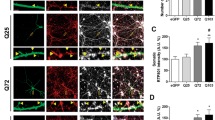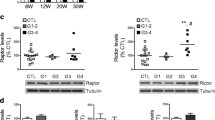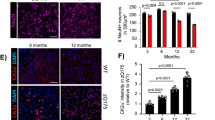Abstract
Cognitive deficits are a major hallmark of Huntington’s disease (HD) with a great impact on the quality of patient’s life. Gaining a better understanding of the molecular mechanisms underlying learning and memory impairments in HD is, therefore, of critical importance. Cdk5 is a proline-directed Ser/Thr kinase involved in the regulation of synaptic plasticity and memory processes that has been associated with several neurodegenerative disorders. In this study, we aim to investigate the role of Cdk5 in learning and memory impairments in HD using a novel animal model that expresses mutant huntingtin (mHtt) and has genetically reduced Cdk5 levels. Genetic reduction of Cdk5 in mHtt knock-in mice attenuated both corticostriatal learning deficits as well as hippocampal-dependent memory decline. Moreover, the molecular mechanisms by which Cdk5 counteracts the mHtt-induced learning and memory impairments appeared to be differentially regulated in a brain region-specific manner. While the corticostriatal learning deficits are attenuated through compensatory regulation of NR2B surface levels, the rescue of hippocampal-dependent memory was likely due to restoration of hippocampal dendritic spine density along with an increase in Rac1 activity. This work identifies Cdk5 as a critical contributor to mHtt-induced learning and memory deficits. Furthermore, we show that the Cdk5 downstream targets involved in memory and learning decline differ depending on the brain region analyzed suggesting that distinct Cdk5 effectors could be involved in cognitive impairments in HD.









Similar content being viewed by others
References
The Huntington’s Disease Collaborative Research Group (1993) A novel gene containing a trinucleotide repeat that is expanded and unstable on Huntington’s disease chromosomes. Cell 72:971–983
Graveland GA, Williams RS, DiFiglia M (1985) Evidence for degenerative and regenerative changes in neostriatal spiny neurons in Huntington’s disease. Science 227(4688):770–773. https://doi.org/10.1126/science.3155875
Reiner A, Albin RL, Anderson KD, D’Amato CJ, Penney JB, Young AB (1988) Differential loss of striatal projection neurons in Huntington disease. Proc Natl Acad Sci U S A 85(15):5733–5737. https://doi.org/10.1073/pnas.85.15.5733
Cepeda C, Wu N, André VM et al (2007) The corticostriatal pathway in Huntington’s disease. Prog Neurobiol 81(5-6):253–271. https://doi.org/10.1016/j.pneurobio.2006.11.001
Ransome MI, Renoir T, Hannan AJ (2012) Hippocampal neurogenesis, cognitive deficits and affective disorder in Huntington’s disease. Neural Plast 2012:1–7. https://doi.org/10.1155/2012/874387
Lawrence AD, Hodges JR, Rosser AE, Kershaw A, ffrench-Constant C, Rubinsztein DC, Robbins TW, Sahakian BJ (1998) Evidence for specific cognitive deficits in preclinical Huntington’s disease. Brain 121(7):1329–1341. https://doi.org/10.1093/brain/121.7.1329
Duff K, Paulsen J, Mills J, Beglinger LJ, Moser DJ, Smith MM, Langbehn D, Stout J et al (2010) Mild cognitive impairment in prediagnosed Huntington’s disease. Neurology 75(6):500–507. https://doi.org/10.1212/WNL.0b013e3181eccfa2
Gray MA, Egan GF, Ando A, Churchyard A, Chua P, Stout JC, Georgiou-Karistianis N (2013) Prefrontal activity in Huntington’s disease reflects cognitive and neuropsychiatric disturbances: the IMAGE-HD study. Exp Neurol 239:218–228. https://doi.org/10.1016/j.expneurol.2012.10.020
Lemiere J, Decruyenaere M, Evers-Kiebooms G, Vandenbussche E, Dom R (2004) Cognitive changes in patients with Huntington’s disease (HD) and asymptomatic carriers of the HD mutation. J Neurol 251(8):935–942. https://doi.org/10.1007/s00415-004-0461-9
Smith R, Brundin P, Li J (2005) Synaptic dysfunction in Huntington’s disease : a new perspective. Cell Mol Life Sci 62(17):1901–1912. https://doi.org/10.1007/s00018-005-5084-5
Nithianantharajah J, Hannan AJ (2013) Dysregulation of synaptic proteins, dendritic spine abnormalities and pathological plasticity of synapses as experience-dependent mediators of cognitive and psychiatric symptoms in Huntington’s disease. Neuroscience 251:66–74. https://doi.org/10.1016/j.neuroscience.2012.05.043
Raymond LA (2016) Striatal synaptic dysfunction and altered calcium regulation in Huntington disease. Biochem Biophys Res Commun 483(4):1051–1062. https://doi.org/10.1016/j.bbrc.2016.07.058
Puigdellívol M, Saavedra A, Pérez-Navarro E (2016) Cognitive dysfunction in Huntington’s disease: mechanisms and therapeutic strategies beyond BDNF. Brain Pathol 1(6):1–59. https://doi.org/10.1111/bpa.12432
Li JY, Plomann M, Brundin P (2003) Huntington’s disease: a synaptopathy? Trends Mol Med 9(10):414–420. https://doi.org/10.1016/j.molmed.2003.08.006
Rozas JL, Gómez-Sánchez L, Tomás-Zapico C, Lucas JJ, Fernández-Chacón R (2010) Presynaptic dysfunction in Huntington’s disease. Biochem Soc Trans 38(2):488–492. https://doi.org/10.1042/BST0380488
Milnerwood AJ, Raymond LA (2007) Corticostriatal synaptic function in mouse models of Huntington’s disease: early effects of huntingtin repeat length and protein load. J Physiol 585(3):817–831. https://doi.org/10.1113/jphysiol.2007.142448
Raymond LA, André VM, Cepeda C, Gladding CM, Milnerwood AJ, Levine MS (2011) Pathophysiology of Huntington’s disease: time-dependent alterations in synaptic and receptor function. Neuroscience 198:252–273. https://doi.org/10.1016/j.neuroscience.2011.08.052
Wang N, Gray M, X-H L, Cantle JP, Holley SM, Greiner E, Gu X, Shirasaki D et al (2014) Neuronal targets for reducing mutant huntingtin expression to ameliorate disease in a mouse model of Huntington’s disease. Nat Med 20(5):536–541. https://doi.org/10.1038/nm.3514
Spires TL, Grote HE, Garry S, Cordery PM, Van Dellen A, Blakemore C, Hannan AJ (2004) Dendritic spine pathology and deficits in experience-dependent dendritic plasticity in R6/1 Huntington’s disease transgenic mice. Neuroscience. https://doi.org/10.1111/j.1460-9568.2004.03374.x
Murmu R, Li W, Holtmaat A, Li J (2013) Dendritic spine instability leads to progressive neocortical spine loss in a mouse model of Huntington’s disease. J Neurosci 33(32):12997–13009. https://doi.org/10.1523/JNEUROSCI.5284-12.2013
Brito V, Giralt A, Enriquez-Barreto L, Puigdellívol M, Suelves N, Zamora-Moratalla A, Ballesteros JJ, Martín ED et al (2014) Neurotrophin receptor p75 NTR mediates Huntington’s disease—associated synaptic and memory dysfunction. J Clin Invest 124(10):4411–4428. https://doi.org/10.1172/JCI74809.long-term
Puigdellívol M, Cherubini M, Brito V, Giralt A, Suelves N, Ballesteros J, Zamora-Moratalla A, Martín ED et al (2015) A role for Kalirin-7 in corticostriatal synaptic dysfunction in Huntington’s disease. Hum Mol Genet 24(25):7265–7285. https://doi.org/10.1093/hmg/ddv426
Herms J, Dorostkar MM (2016) Dendritic spine pathology in neurodegenerative diseases. Annu Rev Pathol 11(1):221–250. https://doi.org/10.1146/annurev-pathol-012615-044216
Tsai LH, Delalle I, Caviness VS, Chae T, Harlow E (1994) P35 is a neural-specific regulatory subunit of cyclin-dependent kinase 5. Nature 371(6496):419–423. https://doi.org/10.1038/371419a0
Dhavan R, Tsai LH (2001) A decade of CDK5. Nat Rev Mol Cell Biol 2(10):749–759. https://doi.org/10.1038/35096019
Angelo M, Plattner F, Giese KP (2006) Cyclin-dependent kinase 5 in synaptic plasticity, learning and memory. J Neurochem 99(2):353–370. https://doi.org/10.1111/j.1471-4159.2006.04040.x
Lai KO, Ip NY (2009) Recent advances in understanding the roles of Cdk5 in synaptic plasticity. Biochim Biophys Acta Mol Basis Dis 1792(8):741–745. https://doi.org/10.1016/j.bbadis.2009.05.001
McLinden KA, Trunova S, Giniger E (2012) At the fulcrum in health and disease: Cdk5 and the balancing acts of neuronal structure and physiology. Brain Disord Ther 1(s1):1–11. https://doi.org/10.4172/2168-975X.S1-001
Li BS, Sun MK, Zhang L, Takahashi S, Ma W, Vinade L, Kulkarni AB, Brady RO et al (2001) Regulation of NMDA receptors by cyclin-dependent kinase-5. Proc Natl Acad Sci U S A 98(22):12742–12747. https://doi.org/10.1073/pnas.211428098
Hawasli AH, Benavides DR, Nguyen C, Kansy JW, Hayashi K, Chambon P, Greengard P, Powell CM et al (2007) Cyclin-dependent kinase 5 governs learning and synaptic plasticity via control of NMDAR degradation. Nat Neurosci 10(7):880–886. https://doi.org/10.1038/nn1914
Plattner F, Hernández A, Kistler TM, Pozo K, Zhong P, Yuen EY, Tan C, Hawasli AH et al (2014) Memory enhancement by targeting Cdk5 regulation of NR2B. Neuron 81(5):1070–1083. https://doi.org/10.1016/j.neuron.2014.01.022
Kim Y, Sung JY, Ceglia I, Lee KW, Ahn JH, Halford JM, Kim AM, Kwak SP et al (2006) Phosphorylation of WAVE1 regulates actin polymerization and dendritic spine morphology. Nature 442(7104):814–817. https://doi.org/10.1038/nature04976
Fu W-Y, Chen Y, Sahin M, Zhao XS, Shi L, Bikoff JB, Lai KO, Yung WH et al (2007) Cdk5 regulates EphA4-mediated dendritic spine retraction through an ephexin1-dependent mechanism. Nat Neurosci 10(1):67–76. https://doi.org/10.1038/nn1811
Xin X, Wang Y, Ma X, Rompolas P, Keutmann HT, Mains RE, Eipper BA (2008) Regulation of Kalirin by Cdk5. J Cell Sci 121(15):2601–2611. https://doi.org/10.1242/jcs.016089
Lai K-O, Liang Z, Fei E, Huang H, Ip NY (2015) Cdk5-dependent phosphorylation of p70 ribosomal S6 kinase (S6K) is required for dendritic spine morphogenesis. J Biol Chem 290(23):14637–14646. https://doi.org/10.1074/jbc.M114.627117
Alexander K, Yang H-S, Hinds PW (2004) Cellular senescence requires CDK5 repression of Rac1 activity. Mol Cell Biol 24(7):2808–2819. https://doi.org/10.1128/MCB.24.7.2808
Posada-Duque RA, López-Tobón A, Piedrahita D, González-Billault C, Cardona-Gomez GP (2015) p35 and Rac1 underlie the neuroprotection and cognitive improvement induced by CDK5 silencing. J Neurochem 134(2):1–17. https://doi.org/10.1111/jnc.13127
Cheung ZH, Ip NY (2012) Cdk5: a multifaceted kinase in neurodegenerative diseases. Trends Cell Biol 22(3):169–175. https://doi.org/10.1016/j.tcb.2011.11.003
SC S, Tsai L-H (2011) Cyclin-dependent kinases in brain development and disease. Annu Rev Cell Dev Biol 27(1):465–491. https://doi.org/10.1146/annurev-cellbio-092910-154023
Lopes JP, Agostinho P (2011) Cdk5: multitasking between physiological and pathological conditions. Prog Neurobiol 94(1):49–63. https://doi.org/10.1016/j.pneurobio.2011.03.006
Paoletti P, Vila I, Rifé M, Lizcano JM, Alberch J, Ginés A (2008) Dopaminergic and glutamatergic signaling crosstalk in Huntington’s disease neurodegeneration: the role of p25/cyclin-dependent kinase 5. J Neurosci 28(40):10090–10101. https://doi.org/10.1523/JNEUROSCI.3237-08.2008
Cherubini M, Puigdellívol M, Alberch J, Ginés S (2015) Cdk5-mediated mitochondrial fission: a key player in dopaminergic toxicity in Huntington’s disease. Biochim Biophys Acta Mol Basis Dis 1852(10):2145–2160. https://doi.org/10.1016/j.bbadis.2015.06.025
Giralt A, Puigdellívol M, Carretón O, Paoletti P, Valero J, Parra-Damas A, Saura CA, Alberch J et al (2012) Long-term memory deficits in Huntington’s disease are associated with reduced CBP histone acetylase activity. Hum Mol Genet 21(6):1203–1216. https://doi.org/10.1093/hmg/ddr552
Gabriel LR, Wu S, Melikian HE (2014) Brain slice biotinylation: an ex vivo approach to measure region-specific plasma membrane protein trafficking in adult neurons. J Vis Exp 1506(86):1–6. https://doi.org/10.3791/51240
Kimura T, Ishiguro K, Hisanaga S-I (2014) Physiological and pathological phosphorylation of tau by Cdk5. Front Mol Neurosci 7:65. https://doi.org/10.3389/fnmol.2014.00065
Barnett DGS, Bibb JA (2011) The role of Cdk5 in cognition and neuropsychiatric and neurological pathology. Brain Res Bull 85(1–2):9–13. https://doi.org/10.1016/j.brainresbull.2010.11.016
Hawasli AH, Bibb JA (2007) Alternative roles for Cdk5 in learning and synaptic plasticity. Biotechnol J 2(8):941–948. https://doi.org/10.1002/biot.200700093
Izquierdo I (1991) Role of NMDA receptors in memory. Trends Pharmacol Sci 12(4):128–129. https://doi.org/10.1016/0165-6147(91)90527-Y
Tang YP, Shimizu E, Dube GR, Rampon C, Kerchner GA, Zhuo M, Liu G, Tsien JZ (1999) Genetic enhancement of learning and memory in mice. Nature 401(6748):63–69. https://doi.org/10.1038/43432
Lau CG, Zukin RS (2007) NMDA receptor trafficking in synaptic plasticity and neuropsychiatric disorders. Nat Rev Neurosci 8(6):413–426. https://doi.org/10.1038/nrn2153
Wang J, Liu S, Fu Y, Wang JH, Lu Y (2003) Cdk5 activation induces hippocampal CA1 cell death by directly phosphorylating NMDA receptors. Nat Neurosci 6(10):1039–1047. https://doi.org/10.1038/nn1119
Lu W, Ai H, Peng L, Wang JJ, Zhang B, Liu X, Luo JH (2015) A novel phosphorylation site of N-methyl-d-aspartate receptor GluN2B at S1284 is regulated by Cdk5 in neuronal ischemia. Exp Neurol 271:251–258. https://doi.org/10.1016/j.expneurol.2015.06.016
Zhang S, Edelmann L, Liu J, Crandall JE, Morabito MA (2008) Cdk5 regulates the phosphorylation of tyrosine 1472 NR2B and the surface expression of NMDA receptors. J Neurosci 28(2):415–424. https://doi.org/10.1523/JNEUROSCI.1900-07.2008
Roskoski R (2005) Src kinase regulation by phosphorylation and dephosphorylation. Biochem Biophys Res Commun 331(1):1–14. https://doi.org/10.1016/j.bbrc.2005.03.012
Sananbenesi F, Fischer A, Wang X, Schrick C, Neve R, Radulovic J, Tsai LH (2007) A hippocampal Cdk5 pathway regulates extinction of contextual fear. Nat Neurosci 10(8):1012–1019. https://doi.org/10.1038/nn1943
Guan JS, Su SC, Gao J, Joseph N, Xie Z, Zhou Y, Durak O, Zhang L et al (2011) Cdk5 is required for memory function and hippocampal plasticity via the camp signaling pathway. PLoS One 6(9):e25735. https://doi.org/10.1371/journal.pone.0025735
Tashiro A, Minden A, Yuste R (2000) Regulation of dendritic spine morphology by the Rho family of small GTPases: antagonistic roles of Rac and Rho. Cereb Cortex 10(10):927–938. https://doi.org/10.1093/cercor/10.10.927
Cheung ZH, AKY F, Ip NY (2006) Synaptic roles of Cdk5: implications in higher cognitive functions and neurodegenerative diseases. Neuron 50(1):13–18. https://doi.org/10.1016/j.neuron.2006.02.024
Park KHJ, Lu G, Fan J, Raymond LA, Leavitt BR (2012) Decreasing levels of the cdk5 activators, p25 and p35, reduces excitotoxicity in striatal neurons. Mol Med 1:97–104. https://doi.org/10.3233/JHD-2012-129000
Bowles KR, Jones L (2014) Kinase Signalling in Huntington’s disease. J Huntingtons Dis 3(2):89–123. https://doi.org/10.3233/JHD-140106
Binukumar BK, Shukla V, Amin ND, Grant P, Bhaskar M, Skuntz S, Steiner J, Pant HC (2015) Peptide TFP5/TP5 derived from Cdk5 activator P35 provides neuroprotection in the MPTP model of Parkinson’s disease. Mol Biol Cell 26(24):4478–4491. https://doi.org/10.1091/mbc.E15-06-0415
Gutiérrez-Vargas JA, Múnera A, Cardona-Gómez GP (2015) CDK5 knockdown prevents hippocampal degeneration and cognitive dysfunction produced by cerebral ischemia. J Cereb Blood Flow Metab 1115545314(12):1–13. https://doi.org/10.1038/jcbfm.2015.150
Luthi-Carter R, Apostol BL, Dunah AW, DeJohn MM, Farrell LA, Bates GP, Young AB, Standaert DG et al (2003) Complex alteration of NMDA receptors in transgenic Huntington’s disease mouse brain: analysis of mRNA and protein expression, plasma membrane association, interacting proteins, and phosphorylation. Neurobiol Dis 14(3):624–636. https://doi.org/10.1016/j.nbd.2003.08.024
Fan MMY, Fernandes HB, Zhang LYJ, Hayden MR, Raymond LA (2007) Altered NMDA receptor trafficking in a yeast artificial chromosome transgenic mouse model of Huntington’s disease. J Neurosci 27(14):3768–3779. https://doi.org/10.1523/JNEUROSCI.4356-06.2007
Luo S, Vacher C, Davies JE, Rubinsztein DC (2005) Cdk5 phosphorylation of huntingtin reduces its cleavage by caspases: implications for mutant huntingtin toxicity. J Cell Biol 169(4):647–656. https://doi.org/10.1083/jcb.200412071
Kaminosono S, Saito T, Oyama F, Ohshima T, Asada A, Nagai Y, Nukina N, Hisanaga S (2008) Suppression of mutant huntingtin aggregate formation by cdk5/p35 through the effect on microtubule stability. J Neurosci 28(35):8747–8755. https://doi.org/10.1523/JNEUROSCI.0973-08.2008
Anne SL, Saudou F, Humbert S (2007) Phosphorylation of huntingtin by cyclin-dependent kinase 5 is induced by DNA damage and regulates wild-type and mutant huntingtin toxicity in neurons. J Neurosci 27(27):7318–7328. https://doi.org/10.1523/JNEUROSCI.1831-07.2007
Tashiro A, Yuste R (2004) Regulation of dendritic spine motility and stability by Rac1 and Rho kinase: evidence for two forms of spine motility. Mol Cell Neurosci 26(3):429–440. https://doi.org/10.1016/j.mcn.2004.04.001
Jaffe AB, Hall A (2005) Rho GTPases: biochemistry and biology. Annu Rev Cell Dev Biol 21(1):247–269. https://doi.org/10.1146/annurev.cellbio.21.020604.150721
Tada T, Sheng M (2006) Molecular mechanisms of dendritic spine morphogenesis. Curr Opin Neurobiol 16(1):95–101. https://doi.org/10.1016/j.conb.2005.12.001
Posada-Duque RA, Palacio-Castañeda V, Cardona-Gómez GP (2015) CDK5 knockdown in astrocytes provide neuroprotection as a trophic source via Rac1. Mol Cell Neurosci 68:151–166. https://doi.org/10.1016/j.mcn.2015.07.001
Posada-Duque RA, Ramirez O, Härtel S, Inestrosa NC, Bodaleo F, González-Billault C, Kirkwood A, Cardona-Gómez GP (2016) CDK5 downregulation enhances synaptic plasticity. Cell Mol Life Sci 74(1):1–20. https://doi.org/10.1007/s00018-016-2333-8
Acknowledgments
We are very grateful to Ana Lopez and Maria Teresa Muñoz for technical assistance, Dr. Teresa Rodrigo and the staff of the animal care facility (Facultat de Psicologia Universitat de Barcelona), and Dr. Maria Calvo, Anna Bosch, and Elisenda Coll from the Advanced Optical Microscopy Unit from Scientific and Technological Centers from the University of Barcelona for their support and advice with confocal technique. We thank Dr. Carles A. Saura for providing the Cre recombinase mice. We thank Dr. Paul Greengard for providing the Cdk5 flox/flox mice. We thank the members of our laboratory for helpful discussion.
Funding
This work was supported by Ministerio de Economía y Competitividad (SAF-2014-57160R to J.A. and SAF2015-67474-R;MINECO/FEDER to S.G.) and Centro de Investigaciones Biomédicas en Red sobre Enfermedades Neurodegenerativas (CIBERNED).
Author information
Authors and Affiliations
Corresponding author
Ethics declarations
All procedures were performed in compliance with the National Institutes of Health Guide for the Care and Use of Laboratory Animals and approved by the local animal care committee of the Universitat de Barcelona (76/15) and Generalitat de Catalunya (00/1094), in accordance with the Directive 2010/63/EU of the European Commission.
Competing Interests
The authors declare that they have no competing interests.
Additional information
The authors wish it to be known that, in their opinion, Elena Alvarez-Periel and Mar Puigdellívol should be regarded as joint first authors.
Electronic Supplementary Material
ESM 1
(PDF 519 kb)
Rights and permissions
About this article
Cite this article
Alvarez-Periel, E., Puigdellívol, M., Brito, V. et al. Cdk5 Contributes to Huntington’s Disease Learning and Memory Deficits via Modulation of Brain Region-Specific Substrates. Mol Neurobiol 55, 6250–6268 (2018). https://doi.org/10.1007/s12035-017-0828-4
Received:
Accepted:
Published:
Issue Date:
DOI: https://doi.org/10.1007/s12035-017-0828-4




